By Stan Friedman
The Las Vegas Strip was up to its blurry eyeballs in power strips January 10-13 as International CES, the world’s largest consumer technology tradeshow, tested the electrical grid of the city’s mammoth convention center and its surrounding hotels.
A mirage of possibilities for the future of homes and libraries seduced the attendees, but there were also plenty of neon warning signs in the guise of overly ambitious product launches and device overkill. For as much as CES professes to be about tomorrow’s technology, one dare not overlook the lessons from its past. In its 44-year history, the show has given us the VCR, the CD player and the Xbox, but also misfires like the cell phone projector, the Sony Rolly dancing music player and the Apple Newton. And with 20,000 gadgets being launched, the law of supply and demand dictates that, for many of this year’s 3,100 exhibitors, what happened in Vegas will no doubt stay in Vegas.
Sidebar below:
My Other Bookmobile Is a Cadillac
And see SLJ‘s coverage of CES:
Digital Publishers Debate What Makes a Great Kids’ Product
Consider, for instance, the handful of tablet brands that have managed a measurable market share in the past 12 months, compared against the more than 100 tablets introduced at the 2011 CES (see “CES 2011: Tablet Crazy,” LJ 2/15/11, p. 42-44). This year, the superslim laptops known as ultrabooks tempt the same fates, with more than 50 models competing for attention. Brand names such as Toshiba, Lenovo, and Acer are in the fray with lightweight machines, less than an inch thick, that feature blazingly fast Intel infrastructure with boot-up speeds as fast as seven seconds.
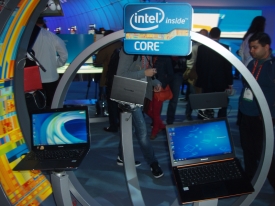 Most ultrabook screens were of the 13- or 14-inch variety, but elsewhere in the convention center screens went to extremes, from the 1.55-inch I’m Watch wrist device to the 92-inch Mitsubishi 3D TV. Speakers followed suit. Geneva Labs showed their wee Model XS Bluetooth speaker/radio with its 2.25-inch woofer, while Behringer blasted out its iNuke Boom, a four-foot-by-eight-foot iPhone docking device that weighs 700 pounds and costs $30,000. Among new tablet offerings, size was both a defining and a confusing feature. Samsung promoted its Galaxy Note as being a phone-like tablet, or perhaps a tablet-like phone, with a stylus-based interface and 5.3-inch display. And a single company, Coby Electronics, introduced five different tablets in 7-, 8-, 9-, 9.7-, and 10-inch sizes.
Most ultrabook screens were of the 13- or 14-inch variety, but elsewhere in the convention center screens went to extremes, from the 1.55-inch I’m Watch wrist device to the 92-inch Mitsubishi 3D TV. Speakers followed suit. Geneva Labs showed their wee Model XS Bluetooth speaker/radio with its 2.25-inch woofer, while Behringer blasted out its iNuke Boom, a four-foot-by-eight-foot iPhone docking device that weighs 700 pounds and costs $30,000. Among new tablet offerings, size was both a defining and a confusing feature. Samsung promoted its Galaxy Note as being a phone-like tablet, or perhaps a tablet-like phone, with a stylus-based interface and 5.3-inch display. And a single company, Coby Electronics, introduced five different tablets in 7-, 8-, 9-, 9.7-, and 10-inch sizes.
While tablets were taking up their share of the physical and psychological real estate, dedicated e-readers were few and far between, perhaps suggesting this technology has gone about as far as it can go. CES attendee Jill Ambrose, chief marketing officer of CourseSmart, a leading digital textbook provider, commented that her company is not interested in supplying content for ereaders because students want devices that do more than just one thing. The French company Bookeen, though, is taking a shot with their Cybook Odyssey. It utilizes a “High Speed Ink System” which, they claim, “boosts the quality of the e-reading experience to an incredibly high level,” but which basically translates as the ability to turn pages really fast. The lesson here is one the Kindle and Nook have already taught: when it comes to e-text, good is probably good enough.
For those of us in the business of serving up information, all these exercises in excess are scenes from a long romance; a 1.8 million-square foot, 153,000-attendee, 17,135-cups-of-coffee celebration of the love triangle that exists between content, devices that provide access to that content, and the availability and connectivity of those devices.
The shape and stability of that triangle, though, has changed this year. Yes, devices are still shiny objects of desire, but they are no longer the hypotenuse of a familiar form. The importance of both content and connectivity, which has been slowly increasing for years, has now shaken the foundation and grown to such a degree that, for 2012, the very name of this gathering has been altered. This was no longer the “Consumer Electronics Show” with its implied emphasis on the apparatus, it is now officially known simply as “International CES.”
Perhaps the Consumer Electronics Association (CEA) is not aware that if there is one thing which bothers a knowledge professional more than a title change, it’s an empty acronym. Thankfully, they have provided an event that does not lack for inspiration. Here then, as fodder for what the letters C and E might stand for the next time around, are three key trends that were spotted, and some related products from the show floor.
Content Eruption
At the September rollout of his latest product, Amazon CEO Jeff Bezos said, “We don’t think of the Kindle Fire as a tablet. We think of it as a service.” This reflects a widely held sentiment that while industrial design, as in Apple’s beautifully crafted hardware, may have been the vanguard of the handheld revolution, the information and entertainment displayed on a screen or broadcast through an earbud is now just as important. Music, e-text, and video rain down to us from the cloud via dozens of providers, and content-rich apps are born at the rate of 15,000 per week.
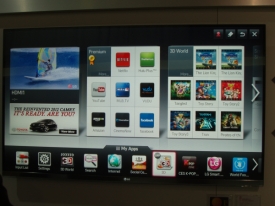 The app-etite among the attendees was more than app-arent. For example, the salespeople at LG’s massive encampment were quick to point out that a highlight of their new 84-inch 3D “ultra-definition” television is its “access to limitless content,” including its Smart TV software with its 1,200-plus apps. Meanwhile, at the entrance to the convention center’s North Hall stood the Wall of Apps, a “curated exhibit” of the latest and greatest mobile must-haves. Among the entries were FlixFling, which allows one to stream movies and fling them from one device to another, and Epson’s iPrint, which transmits online content to any wireless Epson printer. In an upstairs meeting room, it was standing room only for the third annual Mobile Apps Showdown where ten companies gave brief presentations about their latest creations and an applause-o-meter decided the best in show. This year the prize went to Magisto, not a content app, but rather an app for editing content. Shoot a smartphone video and Magisto will choose the best sections and “edit them together to make them look amazing.”
The app-etite among the attendees was more than app-arent. For example, the salespeople at LG’s massive encampment were quick to point out that a highlight of their new 84-inch 3D “ultra-definition” television is its “access to limitless content,” including its Smart TV software with its 1,200-plus apps. Meanwhile, at the entrance to the convention center’s North Hall stood the Wall of Apps, a “curated exhibit” of the latest and greatest mobile must-haves. Among the entries were FlixFling, which allows one to stream movies and fling them from one device to another, and Epson’s iPrint, which transmits online content to any wireless Epson printer. In an upstairs meeting room, it was standing room only for the third annual Mobile Apps Showdown where ten companies gave brief presentations about their latest creations and an applause-o-meter decided the best in show. This year the prize went to Magisto, not a content app, but rather an app for editing content. Shoot a smartphone video and Magisto will choose the best sections and “edit them together to make them look amazing.”
If all of this sounds like child’s play, it should be noted that there were examples of real child’s play to be found as well. Goliaths like Microsoft Kinect and Sony PlayStation dazzled the gamer crowd, but lesser Davids also held forth. The Canadian company Sound Selecta showed off their Art Jam app, a creative tool that turns art into music. It would fit nicely at many a school or public media center, given the availability of headphones. Users assign musical loops to various elements of an animated scene. Touching or repositioning the elements creates a jam, a melodic and visual mashup that can be recorded for posterity. And in the good ol’ world of non-mobile software, Toon Boom Animation allows children to draw cartoons on a PC, enhance them with the help of clip art from the likes of Garfield the cat, add sound, and share over social media.
Connected Experiences
With an increase in content comes an increased need for access. A recent survey by the semiconductor company Broadcom revealed that 22 percent of the 1,025 adults questioned have six or more wireless devices in their homes, and that two-thirds of the respondents would stream content across multiple devices if and when their provider offered the service. Meanwhile, the research firm Parks Associates recently estimated that more than 920 million connected devices will be sold worldwide this year. Online video companies like Netflix have already provided a seamless experience between one’s TV, phone, and tablet. Amazon provides eight different Kindle apps for reading ebooks if one does not own a Kindle. And now, newer companies such as Shodogg, and the appropriately named CRAM Worldwide have products to offer.
Shodogg combines a distributed search engine for video and a cloud-based viewing management system into one easy-to-use app. Register all the web-enabled devices at your disposal, create a sharable playlist of streaming media from multiple sources, then view on any of those registered devices from anywhere there is Internet access.
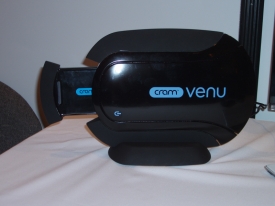 Daren Klum, the CEO of CRAM, is taking a different route. Convinced that the cloud is destined to go the route of the mainframe, Klum’s vision of connectivity is centered around a super-secure hard-drive platform called Venu. The palm-size removable hard drive cartridge is readable only by a single machine, but its content can be broadcast to any device within a secured wifi network. A single cartridge has the capacity to store 200 HD movies, 450 DVDs or 200,000 songs. While currently focused on entertainment content, CRAM hopes to become the go-to provider for storage of personal data, such as medical records, that users would prefer not to have on an off-site machine. And to assure the system is user-friendly, the simple, large-button player, Klum insists, was designed with the help of a focus group of grandmothers.
Daren Klum, the CEO of CRAM, is taking a different route. Convinced that the cloud is destined to go the route of the mainframe, Klum’s vision of connectivity is centered around a super-secure hard-drive platform called Venu. The palm-size removable hard drive cartridge is readable only by a single machine, but its content can be broadcast to any device within a secured wifi network. A single cartridge has the capacity to store 200 HD movies, 450 DVDs or 200,000 songs. While currently focused on entertainment content, CRAM hopes to become the go-to provider for storage of personal data, such as medical records, that users would prefer not to have on an off-site machine. And to assure the system is user-friendly, the simple, large-button player, Klum insists, was designed with the help of a focus group of grandmothers.
Simplicity aside, be it in a home, school, or library, multiple connected devices means multiple problems in terms of power and bandwidth. CES sought to provide answers to these dilemmas as well. For buildings wired with coaxial cable, WiPNET from Wi3 offers a line of in-wall sleeves that bring Ethernet, HDMI (High-Definition Multimedia Interface), and full-strength wi-fi to any room which has a coaxial outlet. Just attach a modem or router to one end of an existing wired network and Ethernet signals are transmitted through the cable to the awaiting wall units.
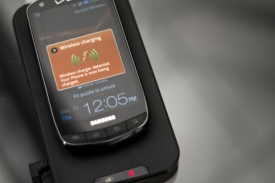 Any librarian who has dealt with keeping multiple devices fully charged will appreciate the efforts of the Wireless Power Consortium, a group of manufacturers working to replace cord chargers with simple wireless countertops and tables. Companies, such as Fulton Innovation, are employing “eCoupling” technology based on inductive coupling that allows electricity to travel via magnetic fields rather than through wires. The result is that any enabled device can simply be set on an eCoupled-ready surface and the charging process begins automatically. Small smartphones and large tablets can simultaneously share a charging space. Many major device makers, including Panasonic, Sony, and Motorola, are members of the consortium, providing real hope for this elegant, ready-for-primetime tech.
Any librarian who has dealt with keeping multiple devices fully charged will appreciate the efforts of the Wireless Power Consortium, a group of manufacturers working to replace cord chargers with simple wireless countertops and tables. Companies, such as Fulton Innovation, are employing “eCoupling” technology based on inductive coupling that allows electricity to travel via magnetic fields rather than through wires. The result is that any enabled device can simply be set on an eCoupled-ready surface and the charging process begins automatically. Small smartphones and large tablets can simultaneously share a charging space. Many major device makers, including Panasonic, Sony, and Motorola, are members of the consortium, providing real hope for this elegant, ready-for-primetime tech.
As for connectivity’s future, Ericsson provided a startling, yet totally likely scenario which they call the “Social Web of Things.” It imagines a time when every object around us is not only connected to one another, but they also all partake in social media. So, instead of an old classmate being a Facebook friend, your new friend list will include your alarm clock, your refrigerator, and the traffic light you travel through on the way to work. Check your newsfeed and you might find a message from your lamp telling you that you forgot to turn him off and would you like to do so now. Select the “yes” button and your action might merit a “like” from the hallway closet that stores your extra bulbs.
Controller Evolution
With an increase in the number of devices owned by a single user comes the need for simplified operation. Shawn DuBravac, CEA’s research director, has proclaimed 2012 the “Year of the Interface,” and there were at least two manifestations of this credo that continually made themselves known. First, mobile devices are increasingly being used as simple substitute controllers for other devices. For many, their smartphone is already their de facto camera. Now they can also use them to turn down the music or turn up the thermostat.
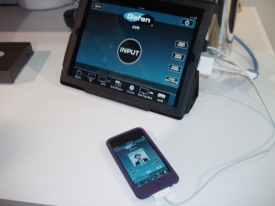 Gefen showed off their Audio/Video Automation System which allows a tablet or smartphone to control all audio and video players throughout a building. It can also be programmed to handle connected lighting devices so one can remotely dim a room to start a presentation. Savant Systems, featured in the NextGen Concept Home in the convention center, showed off their iPad- and iPhone-based software, which can control almost any aspect of a space—from monitoring a security camera, to controlling a home theater, to opening the window shades at a designated time. It also finally gives permission to those who have been dying for a reason to install iPads into their walls.
Gefen showed off their Audio/Video Automation System which allows a tablet or smartphone to control all audio and video players throughout a building. It can also be programmed to handle connected lighting devices so one can remotely dim a room to start a presentation. Savant Systems, featured in the NextGen Concept Home in the convention center, showed off their iPad- and iPhone-based software, which can control almost any aspect of a space—from monitoring a security camera, to controlling a home theater, to opening the window shades at a designated time. It also finally gives permission to those who have been dying for a reason to install iPads into their walls.
Not every device maker is on board with the idea of substitute remotes, thus the second identifier of the Year of the Interface is the rise of new and greatly simplified dedicated controllers. Pushing buttons is so 2011. This year, motion-enabled remotes and other clever tracking technologies are eliminating the need for one’s fingers to do all the work. The aforementioned LG 84-inch TV offers both voice recognition options and a “Magic Motion” remote with just six buttons. It employs a technology that lets one aim-and-click menu options from the screen, essentially transforming it into a wireless mouse.
Pushing the envelope with what was easily the most amazing gizmo to fly under the radar at CES, the folks at Tobii Technology demoed their eye tracking and control system. Using an infrared device built into a laptop, the machine examines the user’s baby blues to determine retina reflection and cornea glint. In a calibration process that takes under 30 seconds, it then transforms a user’s eyes into a hands-free controller allowing one to switch between on-screen documents, or shoot at targets in a game of Asteroids, simply by looking directly at them. It functioned with stunning accuracy and its usefulness—in the disabilities arena alone—should not be, well, overlooked.
Finally, with fingerwork becoming passé, it is worth noting that the next body part to lose steam might possibly be the ear. A new company called AfterShokz has created a pair of headphones that transport sound through the cheekbone using “military special ops bone conduction technology.” It not only eliminates the risk of eardrum damage (by eliminating the eardrum), it also keeps the listener’s ears free to hear what is going on around them, be it oncoming traffic or the announcement that library hours are over.
As they move toward next year’s event, the overseers of International CES might want to invest in a pair of AfterShokz themselves, to help mute the ongoing debate surrounding its timing and usefulness. Apple long ago gave up presenting here and Microsoft has announced that this will be their last year. Critics have pointed out that January is a long way off from the next holiday selling season, yet close enough to the last one to upset those who received a toy that is no longer the coolest on the block.
But, as Yogi Berra might have observed had he attended this year’s show, no one goes here nowadays, it’s too crowded. If the big names are slowly vanishing, the trenches are more crowded than ever with buyers and sellers of accessories like smartphone mounts and tablet covers. It’s not glamorous, it’s just business. Still, if the CE industry continues on its path away from devices and toward content and connectivity, it will take more than just a name change to keep this elephantine production from sinking into the sands of Vegas.
Stan Friedman (@StanfordF) is the Senior Research Librarian for Condé Nast in New York City, and a freelance critic, poet, and novelist (his novel, God’s Gift to Women, was published in ebook format in 2010 by Scott & Nix, Inc.).
My Other Bookmobile Is a Cadillac
Up and down Las Vegas Boulevard, visitors stop to admire the parade of impressive autos cruising by, from stretch limos to vintage sports cars. Oddly though, on our recent visit, not a single bookmobile was sighted. Perhaps there is a stigma. Perhaps libraries feel their mobile units are not rad enough for The Strip. But just imagine the admiring glances from your patrons were you to trick out your library’s ride with some of these auto tech goodies available at this year’s International CES.
CUE (Cadillac User Experience) by GM
This dashboard infotainment system not only responds to voice commands, it will read text messages aloud. It has 3D GPS navigation, map-integrated Doppler weather info and Pandora Radio. It has the ability to pair entertainment and informational data from up to 10 Bluetooth-enabled mobile devices, USBs, SD cards and MP3 players and will even aggregate files from those multiple devices into a single playlist.
The Tailgater is a portable antenna that, when paired with a Dish receiver, will deliver high definition satellite programming to your TV-filled bookmobile. The unit weighs in at just ten pounds and features automatic positioning with no need for manual adjustments.
iOnRoad by Picitup
This clever app turns your smartphone into an early warning traffic device.  Using their special mount, attach a phone to the windshield of your bookmobile and fire it up. Using the device’s camera functionality, the app will track traffic conditions and give an alert if you get too close to the vehicle ahead of you or stray toward the shoulder of the road.
Using their special mount, attach a phone to the windshield of your bookmobile and fire it up. Using the device’s camera functionality, the app will track traffic conditions and give an alert if you get too close to the vehicle ahead of you or stray toward the shoulder of the road.
The Magellan Wireless Back-up Camera
A must-have safety add-on for the Magellan GPS system, this small camera attaches to the back of the bookmobile, near the license plate. Shift into reverse and the dashboard-mounted GPS unit transforms into a video monitor displaying what is happening behind the vehicle. The camera boasts a wide-angle view lens with a 120-degree horizontal and 100-degree vertical viewing area.
Road Mice by Four Door Media
Even if your bookmobile has trouble reaching the legal speed limit, your onboard computers can sport these souped-up mice which are perfect replicas of famous roadsters. 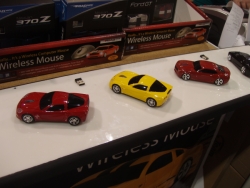 Each mini Jaguar, Mustang, or Lamborghini is officially licensed by their respective automaker and feature the same factory paint colors as their large-size siblings. The custom wheels are rubber, the bodies are high impact and the headlights are fully functional. Each mouse comes with a complete bumper to bumper warranty and its own VIN number to help prevent theft. Under the hood are two AAA batteries, 800 dots-per-inch optical resolution and 2.4 gigahertz of wireless connectivity.
Each mini Jaguar, Mustang, or Lamborghini is officially licensed by their respective automaker and feature the same factory paint colors as their large-size siblings. The custom wheels are rubber, the bodies are high impact and the headlights are fully functional. Each mouse comes with a complete bumper to bumper warranty and its own VIN number to help prevent theft. Under the hood are two AAA batteries, 800 dots-per-inch optical resolution and 2.4 gigahertz of wireless connectivity.

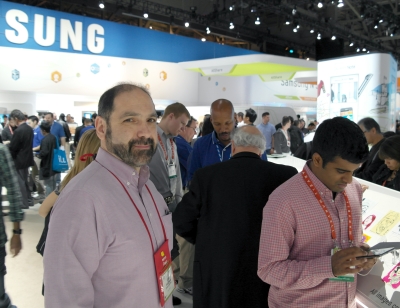
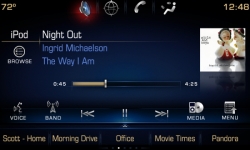
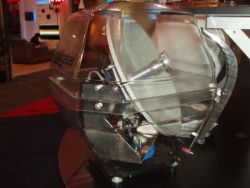
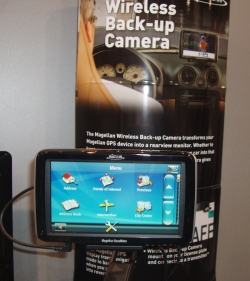


Thanks, Stan, for this lucid, intriguing, info-packed, piece. Am gonna get one of those car mice asap.
Reaaly want one of those mice. Going to have to check it out.
The idea of controlling all the devices in a building, from a smartphone or tablet is definitely one of the coolest things that is being developed. Just like the days of having 5 remotes to control your TV and entertainment system, it’s going to be awesome to have one controller for all of the devices in your home. We’re still not there quite yet. Samsung is jumping on the bandwagon of a “smart home” where you can monitor and control everything in your home, from your smartphone but it’s still not mainstream yet. Making things universal and able to be controlled from one device, will rely on companies banding together to either come out with a universal language for controlling the devices or releasing APIs for controlling their devices from a smartphone. Hopefully we will see this technology well developed and available everywhere soon.